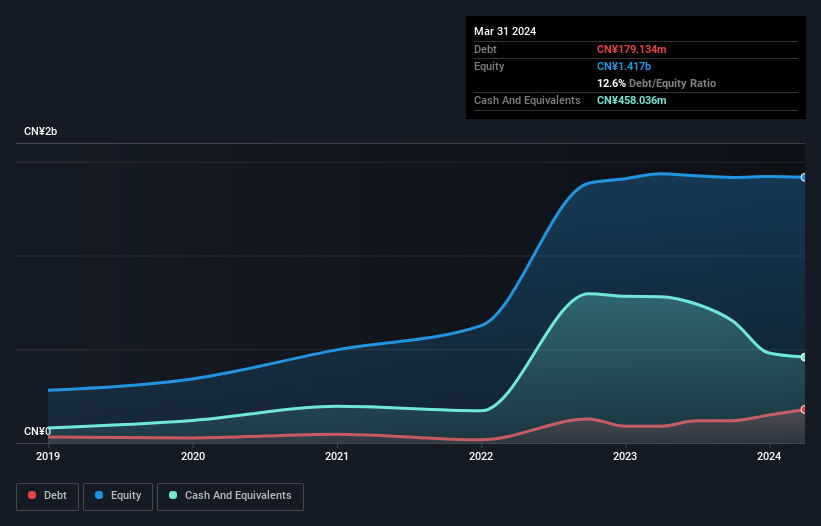- China
- /
- Electronic Equipment and Components
- /
- SZSE:301205
Is Linktel Technologies (SZSE:301205) A Risky Investment?
Howard Marks put it nicely when he said that, rather than worrying about share price volatility, 'The possibility of permanent loss is the risk I worry about... and every practical investor I know worries about.' It's only natural to consider a company's balance sheet when you examine how risky it is, since debt is often involved when a business collapses. We note that Linktel Technologies Co., Ltd. (SZSE:301205) does have debt on its balance sheet. But the real question is whether this debt is making the company risky.
When Is Debt Dangerous?
Debt assists a business until the business has trouble paying it off, either with new capital or with free cash flow. In the worst case scenario, a company can go bankrupt if it cannot pay its creditors. While that is not too common, we often do see indebted companies permanently diluting shareholders because lenders force them to raise capital at a distressed price. Of course, the upside of debt is that it often represents cheap capital, especially when it replaces dilution in a company with the ability to reinvest at high rates of return. The first thing to do when considering how much debt a business uses is to look at its cash and debt together.
View our latest analysis for Linktel Technologies
What Is Linktel Technologies's Debt?
You can click the graphic below for the historical numbers, but it shows that as of March 2024 Linktel Technologies had CN¥179.1m of debt, an increase on CN¥89.1m, over one year. But it also has CN¥458.0m in cash to offset that, meaning it has CN¥278.9m net cash.

How Strong Is Linktel Technologies' Balance Sheet?
We can see from the most recent balance sheet that Linktel Technologies had liabilities of CN¥316.6m falling due within a year, and liabilities of CN¥9.30m due beyond that. Offsetting this, it had CN¥458.0m in cash and CN¥169.9m in receivables that were due within 12 months. So it actually has CN¥302.1m more liquid assets than total liabilities.
This short term liquidity is a sign that Linktel Technologies could probably pay off its debt with ease, as its balance sheet is far from stretched. Simply put, the fact that Linktel Technologies has more cash than debt is arguably a good indication that it can manage its debt safely. When analysing debt levels, the balance sheet is the obvious place to start. But you can't view debt in total isolation; since Linktel Technologies will need earnings to service that debt. So if you're keen to discover more about its earnings, it might be worth checking out this graph of its long term earnings trend.
In the last year Linktel Technologies had a loss before interest and tax, and actually shrunk its revenue by 27%, to CN¥606m. That makes us nervous, to say the least.
So How Risky Is Linktel Technologies?
Statistically speaking companies that lose money are riskier than those that make money. And we do note that Linktel Technologies had an earnings before interest and tax (EBIT) loss, over the last year. And over the same period it saw negative free cash outflow of CN¥364m and booked a CN¥4.7m accounting loss. With only CN¥278.9m on the balance sheet, it would appear that its going to need to raise capital again soon. Overall, its balance sheet doesn't seem overly risky, at the moment, but we're always cautious until we see the positive free cash flow. There's no doubt that we learn most about debt from the balance sheet. However, not all investment risk resides within the balance sheet - far from it. We've identified 1 warning sign with Linktel Technologies , and understanding them should be part of your investment process.
If you're interested in investing in businesses that can grow profits without the burden of debt, then check out this free list of growing businesses that have net cash on the balance sheet.
New: AI Stock Screener & Alerts
Our new AI Stock Screener scans the market every day to uncover opportunities.
• Dividend Powerhouses (3%+ Yield)
• Undervalued Small Caps with Insider Buying
• High growth Tech and AI Companies
Or build your own from over 50 metrics.
Have feedback on this article? Concerned about the content? Get in touch with us directly. Alternatively, email editorial-team (at) simplywallst.com.
This article by Simply Wall St is general in nature. We provide commentary based on historical data and analyst forecasts only using an unbiased methodology and our articles are not intended to be financial advice. It does not constitute a recommendation to buy or sell any stock, and does not take account of your objectives, or your financial situation. We aim to bring you long-term focused analysis driven by fundamental data. Note that our analysis may not factor in the latest price-sensitive company announcements or qualitative material. Simply Wall St has no position in any stocks mentioned.
About SZSE:301205
Linktel Technologies
Focuses on the research and development, production, and sale of optical transceiver modules in China and internationally.
High growth potential with proven track record.
Market Insights
Community Narratives



